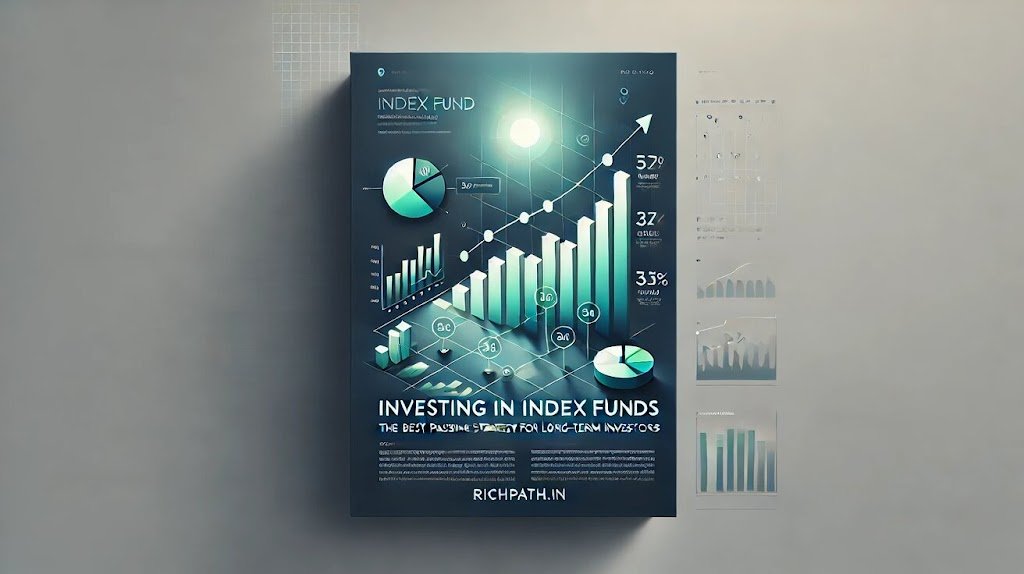Investing in Index Funds: The Best Passive Strategy for Long-Term Investors

Investing can feel overwhelming, with numerous options, complex strategies, and constant market fluctuations. However, for those looking for a simple, low-cost, and effective way to build wealth, investing in index funds best passive strategy stands out as the ideal approach. Whether you’re a beginner or an experienced investor, index funds offer an easy way to participate in the stock market’s long-term growth without the hassle of active stock selection.
In this guide, we’ll explore why investing in index funds best passive strategy is the smartest choice, how these funds work, and the key benefits they offer. We’ll also provide real-life examples and practical steps to get started.
What Are Index Funds?
Index funds are mutual funds or exchange-traded funds (ETFs) designed to track a specific market index, such as the Nifty 50 or Sensex in India. Instead of relying on a fund manager to actively select stocks, an index fund simply replicates the index by holding all its stocks in the same proportion.
For example, if you invest in a Nifty 50 Index Fund, your money is distributed among the top 50 companies, including Reliance Industries, TCS, Infosys, and HDFC Bank. As the index grows, so does your investment. This passive approach makes investing in index funds best passive strategy for those looking for long-term, stress-free wealth creation.
Why Investing in Index Funds Best Passive Strategy Works
1. Simplicity and Transparency
Index funds eliminate the need for extensive market research and active trading. Since they track an index, their investment process is straightforward and transparent.
Take the case of Rajesh, a school teacher in Pune, who wanted to invest for his daughter’s education but had no time for stock research. He opted for a Sensex Index Fund, and over 15 years, his investment grew steadily, requiring no effort on his part.
2. Lower Costs Compared to Active Funds
One of the biggest advantages of investing in index funds best passive strategy is the lower expense ratio. Unlike actively managed funds that charge high management fees (1.5%-2.5%), index funds typically have an expense ratio as low as 0.2%-0.5%, helping investors save lakhs over the years.
For example, Priya, a working professional in Delhi, compared two funds—a large-cap mutual fund with a 2% expense ratio and an index fund with a 0.3% expense ratio. Over 20 years, she saved more than ₹5 lakh in fees, significantly boosting her final corpus.
3. Consistent and Reliable Performance
Studies show that most actively managed funds fail to beat the market consistently over time. On the other hand, index funds mirror the market’s performance, ensuring steady growth without the risk of underperformance.
Between 2010 and 2020, the Nifty 50 delivered an annualized return of around 11%. A Nifty 50 index fund would have provided nearly identical returns, while many actively managed funds struggled to keep pace.
The Power of Compounding with Index Funds
One of the biggest reasons why investing in index funds best passive strategy is so effective is the power of compounding. When you reinvest earnings, your wealth grows exponentially over time.
For instance, Anil, a 25-year-old IT professional from Bengaluru, started investing ₹5,000 per month in an index fund tracking Sensex. Assuming an average 12% annual return, his portfolio grew to over ₹2 crore by the time he was 55—without picking stocks or timing the market.
Key Benefits of Investing in Index Funds
1. Diversification Without Extra Effort
Index funds automatically spread your investment across multiple sectors. A Nifty 50 index fund, for example, includes companies from industries such as banking, IT, healthcare, and energy, reducing the impact of poor performance in any single sector.
2. No Emotional Decision-Making
Active investors often make emotional decisions, buying high and selling low. Since index funds follow a fixed strategy, they eliminate emotional trading, ensuring a disciplined investment approach.
For instance, during the 2020 COVID-19 crash, many investors sold their stocks in panic. However, those who stayed invested in index funds saw their portfolios recover and grow significantly when the market rebounded.
3. High Tax Efficiency
Because index funds have lower turnover rates than actively managed funds, they generate fewer capital gains, leading to lower tax liability for investors.
Best Index Funds in India
If you’re considering investing in index funds best passive strategy, here are some top-performing options in India:
- UTI Nifty Index Fund – Tracks Nifty 50, low-cost, ideal for long-term wealth creation.
- HDFC Index Fund – Sensex Plan – Follows Sensex, providing exposure to India’s top companies.
- ICICI Prudential Nifty Next 50 Index Fund – Offers growth potential beyond the top 50 companies.
- SBI Nifty 50 Index Fund – Consistently matches the Nifty 50 returns.
- Nippon India ETF Nifty BeES – ETF option for flexibility in trading.
How to Start Investing in Index Funds
Starting your journey with investing in index funds best passive strategy is easy. Follow these steps:
Step 1: Define Your Investment Goals
Decide why you’re investing—retirement, home purchase, children’s education, or wealth creation.
Step 2: Select the Right Index Fund
Compare funds based on factors like expense ratio, tracking error, and past performance.
Step 3: Start a SIP (Systematic Investment Plan)
SIPs help you invest consistently and benefit from rupee cost averaging.
Step 4: Stay Invested for the Long Term
Avoid panic selling during market downturns and let compounding work its magic.
Real-Life Success Story
Sneha, a 30-year-old marketing executive from Mumbai, started a ₹10,000 monthly SIP in a Nifty 50 index fund in 2015. Despite market fluctuations, she held onto her investments, and by 2023, her portfolio had grown to over ₹15 lakh. This proves that investing in index funds best passive strategy helps build wealth with minimal effort.
Common Myths About Index Funds
Myth 1: Index Funds Are Risk-Free
While index funds reduce individual stock risk, they still follow the market and can fluctuate in the short term.
Myth 2: They Offer Only Average Returns
Though index funds “match” the market, they often outperform most actively managed funds over time.
Myth 3: You Need a Lot of Money to Start
With SIPs starting at just ₹500, anyone can start investing in index funds.
Conclusion
For long-term wealth creation, investing in index funds best passive strategy remains the simplest and most effective method. Low costs, diversification, and compounding power make index funds the ideal choice for both beginners and experienced investors.
If you’re looking for a hassle-free, high-return investment strategy, start your index fund SIP today. Remember, patience and consistency are the keys to success. As Warren Buffett wisely said, “The stock market is a device for transferring money from the impatient to the patient.”
Now is the time to let index funds work their magic and secure your financial future!
For expert financial insights, visit Rich Path. and start your investment journey today! 🚀
Read more –
How Long-Term Investments Can Secure Your Retirement
How to Plan Your Retirement in Your 40s with Just ₹1,000 Monthly Using Mutual Funds








